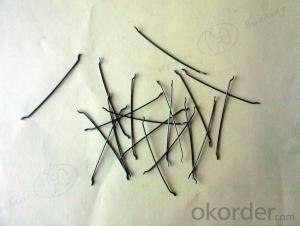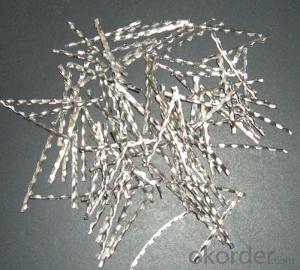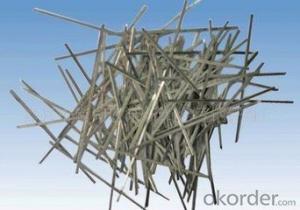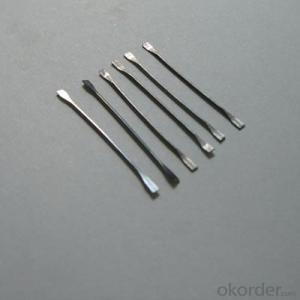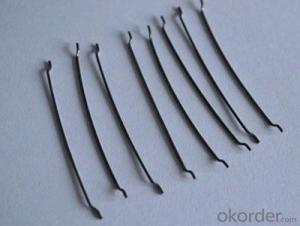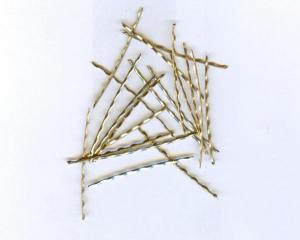Steel Fiber Straight Type From Company CNBM Inernational
- Loading Port:
- Tianjin
- Payment Terms:
- TT OR LC
- Min Order Qty:
- 1000 kg
- Supply Capability:
- 30000 kg/month
OKorder Service Pledge
OKorder Financial Service
You Might Also Like
Quick Details
Place of Origin: Shandong, China (Mainland)
Brand Name: CNBM
Model Number: LONGSTONE
Material: Stainless Steel
Specifications
Specifications
Produces shear type, steel wire type, cut type, stainless type, and micro wire type steel fiber. It is used for concret.
SPECIFICATION
TYPE | SIZE | tensile strength |
ENDHOOKED STEEL FIBER | 0.5×0.5×30 mm | 850Mpa min |
0.6×0.7×35 mm | 850Mpa min | |
0.5×0.5×30 mm | 1000MPA min | |
0.6×35 mm | 1000MPA min | |
0.9×60 mm | 1000MPA min | |
CORRUGATED STEEL FIBER | 0.25×0.25×10 mm | 380Mpa min |
0.25×0.25×14 mm | 380Mpa min | |
0.5×0.7×32 mm | 380MPA min |
OTHER SPECIFICATIONS CAN BE DISCUSSED AS PER BUYER’S OPTION
Picture
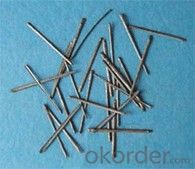
Steel fiber straight type
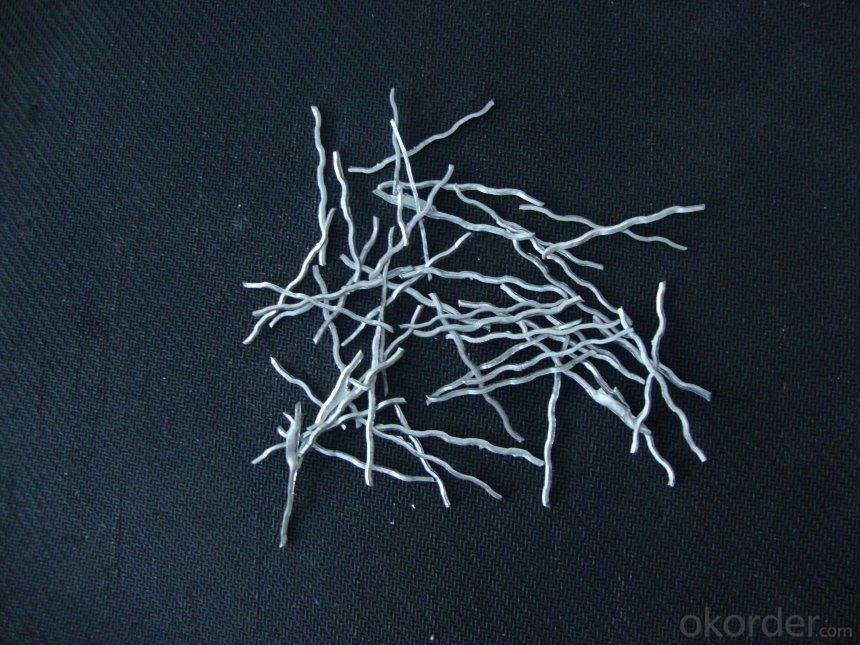
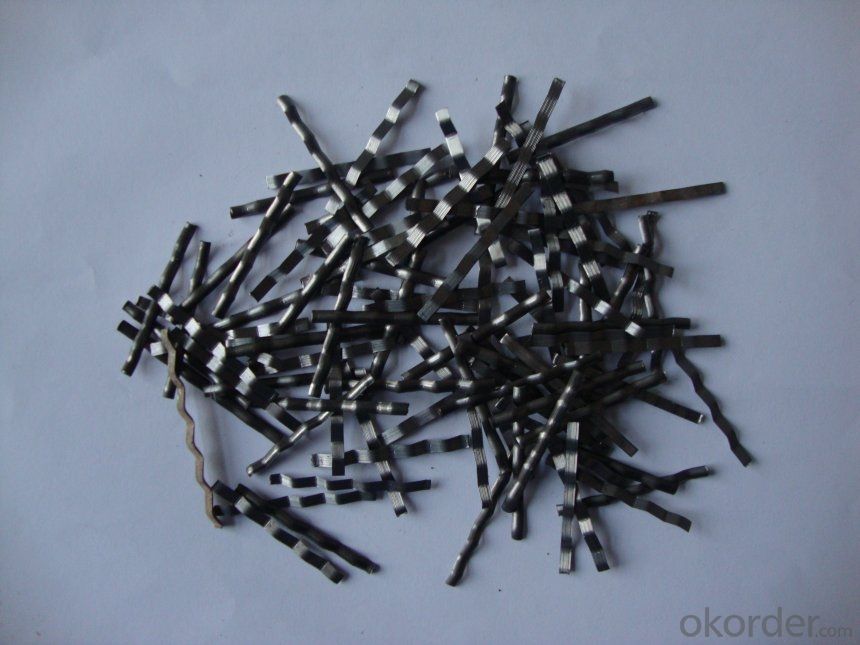
FAQ
certificated: ISO 9001
Technical advantages of Daye steel fiber:
A. Improve mechanical performance of concrete
B. Provide uniform distribution throughout concrete with excellent mixing
C. No balling or caking by adopt correct mixing method
D. Reduce concrete volume
E.Save construction time and cost
F.Reduce excavation volume
G.Available for jointless floor.
- Q:Does melt extract stainless steel fiber improve the resistance to carbonation in shotcrete?
- Yes, melt extract stainless steel fiber does improve the resistance to carbonation in shotcrete.
- Q:How does melt extract stainless steel fiber enhance the durability of composite materials?
- Melt extract stainless steel fiber enhances the durability of composite materials in several ways. Firstly, the addition of stainless steel fibers improves the overall mechanical strength and toughness of the composite. The fibers act as reinforcement, providing additional structural integrity and preventing crack propagation. This results in a composite material that is more resistant to bending, impact, and fatigue, thus increasing its durability. Furthermore, the corrosion resistance of stainless steel fibers enhances the durability of the composite in harsh environments. Stainless steel is known for its excellent resistance to corrosion, even in acidic or alkaline conditions. By incorporating stainless steel fibers, the composite material becomes more resistant to chemical degradation, ensuring its longevity and performance over time. Another important aspect is the thermal stability that stainless steel fibers provide to the composite. Stainless steel has a high melting point and can withstand extreme temperatures, making it ideal for applications that require resistance to heat and fire. By incorporating melt extract stainless steel fibers, the composite material becomes more resistant to thermal degradation, ensuring its durability even in high-temperature environments. Lastly, the dimensional stability of composite materials is improved with the addition of stainless steel fibers. These fibers help to minimize dimensional changes due to temperature variations, reducing the risk of warping or distortion. This enhanced dimensional stability enhances the overall durability of the composite, making it suitable for a wide range of applications where precision and stability are crucial. In summary, melt extract stainless steel fiber enhances the durability of composite materials through improved mechanical strength, corrosion resistance, thermal stability, and dimensional stability. These properties make the composite material more robust, long-lasting, and capable of withstanding various environmental and operational conditions.
- Q:What is the effect of melt extract stainless steel fiber on the thermal conductivity of concrete?
- The thermal conductivity of concrete can be greatly improved by incorporating melt extract stainless steel fiber. Stainless steel fibers possess excellent thermal conductivity properties, enabling them to effectively transfer heat throughout the concrete. When these fibers are added to the concrete mixture, they create a three-dimensional network that aids in the efficient conduction and distribution of heat. This enhanced thermal conductivity has multiple positive impacts on the performance of the concrete. To begin with, the heightened thermal conductivity can enhance the overall thermal efficiency of structures constructed with this particular type of concrete. It facilitates better heat transfer, leading to more efficient temperature regulation and reducing the need for additional insulation or heating and cooling systems. Furthermore, the improved thermal conductivity can also enhance the durability of the concrete. By evenly distributing heat and minimizing temperature variations, the risk of thermal cracking and damage due to expansion and contraction is diminished. This is particularly advantageous in environments with substantial temperature fluctuations. Moreover, the greater thermal conductivity provided by melt extract stainless steel fiber can also be beneficial in applications like radiant floor heating systems. The fibers effectively transfer heat from the heating elements to the surface, resulting in more efficient and effective heating. In conclusion, the incorporation of melt extract stainless steel fiber in concrete significantly improves its thermal conductivity. This improvement leads to increased thermal efficiency, enhanced durability, and improved performance in various applications where heat transfer is crucial.
- Q:What is the recommended fiber dosage when using melt extract stainless steel fiber in shotcrete?
- The recommended fiber dosage when using melt extract stainless steel fiber in shotcrete varies depending on the specific project requirements and the desired performance characteristics. However, a general guideline for the fiber dosage in shotcrete is typically in the range of 20 to 40 kilograms per cubic meter (kg/m3) or 1.2 to 2.4 pounds per cubic yard (lb/yd3). This dosage range provides sufficient reinforcement and enhances the overall durability, crack resistance, and impact resistance of the shotcrete. It is important to consult with the manufacturer or a qualified engineer to determine the exact fiber dosage based on the specific project needs and requirements.
- Q:How does melt extract stainless steel fiber improve the strength of concrete?
- Melt extract stainless steel fiber improves the strength of concrete by enhancing its tensile and flexural properties. The addition of these fibers helps to distribute the stresses more evenly throughout the concrete matrix, effectively reducing cracking and increasing its resistance to various types of loading. Moreover, the steel fibers act as reinforcement, providing additional strength and durability to the concrete, making it more resistant to impact, cyclic loading, and overall structural integrity.
- Q:Can melt extract stainless steel fiber be used in tunnel shotcreting applications?
- Tunnel shotcreting applications can benefit from the use of melt extract stainless steel fiber. This process involves applying a concrete or mortar mix to the walls of a tunnel or underground structure using a spraying technique. By adding stainless steel fibers to the shotcrete mix, reinforcement is provided, resulting in improved overall performance and durability of the sprayed concrete. Melt extract stainless steel fibers are commonly utilized in shotcrete applications due to their high tensile strength, resistance to corrosion, and ability to enhance the post-cracking behavior of the concrete. These fibers are created by melting stainless steel, rapidly cooling it, and forming fine, elongated fibers. The inclusion of stainless steel fibers in tunnel shotcreting helps prevent crack formation and controls crack propagation, thereby increasing the structural integrity and longevity of the sprayed concrete. These fibers also enhance the shotcrete's resistance to impact, abrasion, and spalling, which are common challenges encountered in tunnel construction. Furthermore, the addition of stainless steel fibers improves the overall performance of the shotcrete by reducing shrinkage and enhancing the bond strength between the shotcrete and the tunnel surface. This is particularly crucial in tunnel shotcreting applications where it is necessary for the sprayed concrete to adhere well to the surrounding rock or soil. To conclude, melt extract stainless steel fiber proves to be an effective addition in tunnel shotcreting applications as it enhances the durability, strength, and performance of the sprayed concrete. Its incorporation helps overcome common challenges in tunnel construction and ultimately improves the quality of the tunnel walls.
- Q:How does melt extract stainless steel fiber prevent plastic shrinkage cracking in concrete?
- Melt extract stainless steel fiber serves as a reinforcement material widely employed in concrete to mitigate the occurrence of plastic shrinkage cracking. This type of cracking arises when the concrete surface rapidly dries, leading to shrinkage and cracking before complete hardening. During the concrete mixing process, stainless steel fibers are incorporated into the mix. These fibers possess a remarkably thin structure and exhibit a high tensile strength, enabling them to endure substantial stress without fracturing. As the concrete begins to dry and contract, the stainless steel fibers uniformly distribute the stress throughout the concrete matrix, thus preventing the formation of sizable cracks. Moreover, the presence of these fibers aids in reducing the overall drying shrinkage of the concrete. This is due to the fact that the fibers establish a network within the concrete, binding it together and restricting the movement of individual particles. Consequently, as the concrete dries, it experiences diminished shrinkage, thereby minimizing the likelihood of cracking. Furthermore, the incorporation of stainless steel fibers enhances the durability and toughness of the concrete as a whole. These fibers heighten resistance to impact, abrasion, and cracking, rendering the concrete more resilient and long-lasting. In conclusion, by providing reinforcement and diminishing overall shrinkage, melt extract stainless steel fiber plays a pivotal role in the prevention of plastic shrinkage cracking in concrete. Its inclusion in concrete mixes ensures that the surface remains intact and structurally sound, even during the initial stages of drying and hardening.
- Q:What are the advantages of melt extract stainless steel fiber over other types of steel fibers?
- Melt extract stainless steel fibers offer several advantages over other types of steel fibers. Firstly, melt extract stainless steel fibers have excellent corrosion resistance. Stainless steel contains a high amount of chromium, which forms a protective oxide layer on the surface of the fibers. This oxide layer acts as a barrier against corrosive elements, making them highly resistant to rust and deterioration. This advantage is especially crucial in environments where exposure to moisture, chemicals, or high temperatures is common. Secondly, melt extract stainless steel fibers have superior mechanical properties compared to other steel fibers. These fibers are made by melting the steel and then rapidly extracting it into fine filaments. This process creates fibers with high tensile strength, allowing them to withstand heavy loads and resist deformation under stress. This strength also enhances the durability and lifespan of structures reinforced with melt extract stainless steel fibers. Additionally, melt extract stainless steel fibers have a high melting point, making them suitable for use in high-temperature applications. These fibers can withstand extreme heat without losing their structural integrity, making them ideal for reinforcing concrete in environments such as industrial furnaces, fire-resistant structures, and thermal power plants. Furthermore, the fine and uniform nature of melt extract stainless steel fibers allows for better dispersion throughout the concrete matrix. This results in enhanced crack resistance and improved load-bearing capacity of the reinforced concrete. The small diameter of these fibers also facilitates better bonding with the surrounding concrete, leading to increased bond strength and overall structural performance. Lastly, melt extract stainless steel fibers offer excellent electrical conductivity. This makes them suitable for applications where electrical grounding or conductivity is required, such as in electromagnetic shielding or in structures exposed to electrical currents. In summary, the advantages of melt extract stainless steel fibers include superior corrosion resistance, high mechanical strength, resistance to high temperatures, improved crack resistance, enhanced bond strength, and excellent electrical conductivity. These factors make them a preferred choice over other types of steel fibers for a wide range of applications, including construction, infrastructure, and industrial sectors.
- Q:How does melt extract stainless steel fiber affect the abrasion resistance of concrete?
- Concrete's abrasion resistance can be significantly improved by incorporating melt extract stainless steel fiber. These fibers create a three-dimensional reinforcement network within the concrete, enhancing its strength and durability. The unique properties of stainless steel, such as its high tensile strength and corrosion resistance, contribute to the improved abrasion performance. The addition of these fibers helps prevent the formation of microcracks and control the propagation of existing cracks in the concrete. As a result, the concrete becomes more resistant to wear and tear caused by abrasion. The fibers act as reinforcement, strengthening the concrete by bridging gaps between aggregates and providing additional tensile strength. By incorporating stainless steel fibers, the concrete gains increased resistance to surface erosion, impact, and friction. This is particularly beneficial in high-traffic areas like industrial floors, highways, parking lots, and airports, where abrasion is common. The improved abrasion resistance ensures that the concrete remains intact and maintains its structural integrity over a longer period. Moreover, melt extract stainless steel fibers also extend the overall lifespan of concrete structures. By reducing the need for repairs and maintenance due to abrasion damage, these fibers help save costs and minimize environmental impact. To summarize, melt extract stainless steel fiber greatly enhances concrete's abrasion resistance by reinforcing the material, reducing crack formation, and improving its strength and durability. This makes it an excellent choice for applications where abrasion is a concern, resulting in longer-lasting and more resilient concrete structures.
- Q:Can melt extract stainless steel fiber be used in fiber-reinforced polymers?
- Fiber-reinforced polymers (FRPs) can benefit from the utilization of melt extract stainless steel fiber. These fibers, obtained through a specialized process, offer uniformity and high quality. By incorporating stainless steel fibers into polymer matrices, the mechanical properties of FRPs, such as tensile strength, flexural strength, and impact resistance, can be improved. This enhancement makes the composite material suitable for applications that demand a high strength-to-weight ratio. Furthermore, the addition of stainless steel fibers enhances the fracture toughness of FRPs, making them more resistant to crack propagation. This characteristic is especially important in situations where impact resistance plays a significant role. Moreover, the corrosion resistance offered by stainless steel fibers proves advantageous in environments with harsh conditions, including moisture, chemicals, or high temperatures. These fibers prevent corrosion of the composite material, thereby increasing its lifespan and reliability. Overall, the integration of melt extract stainless steel fibers into FRPs significantly boosts the mechanical properties and durability of the composite material. Consequently, it becomes suitable for a wide range of applications in industries such as automotive, construction, aerospace, and marine.
1. Manufacturer Overview |
|
|---|---|
| Location | |
| Year Established | |
| Annual Output Value | |
| Main Markets | |
| Company Certifications | |
2. Manufacturer Certificates |
|
|---|---|
| a) Certification Name | |
| Range | |
| Reference | |
| Validity Period | |
3. Manufacturer Capability |
|
|---|---|
| a)Trade Capacity | |
| Nearest Port | |
| Export Percentage | |
| No.of Employees in Trade Department | |
| Language Spoken: | |
| b)Factory Information | |
| Factory Size: | |
| No. of Production Lines | |
| Contract Manufacturing | |
| Product Price Range | |
Send your message to us
Steel Fiber Straight Type From Company CNBM Inernational
- Loading Port:
- Tianjin
- Payment Terms:
- TT OR LC
- Min Order Qty:
- 1000 kg
- Supply Capability:
- 30000 kg/month
OKorder Service Pledge
OKorder Financial Service
Similar products
New products
Hot products
Hot Searches
Related keywords
